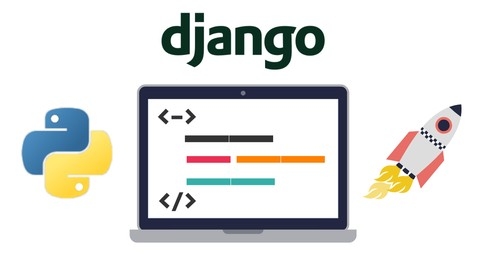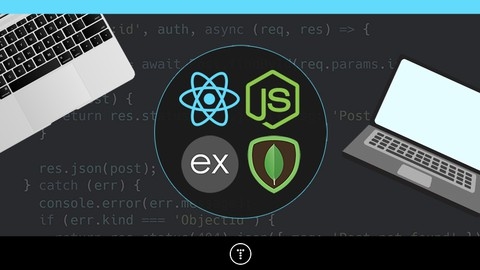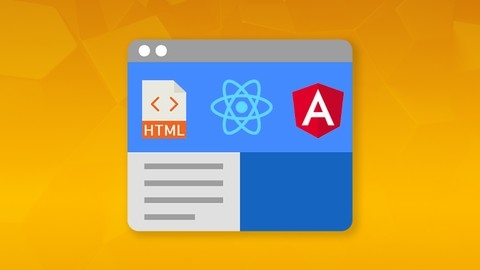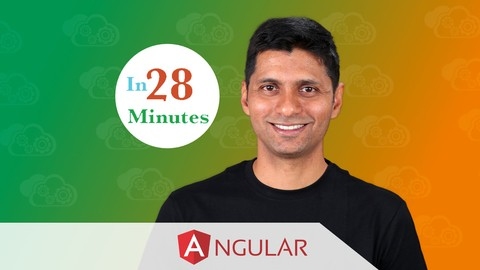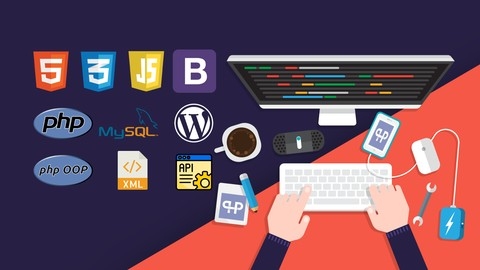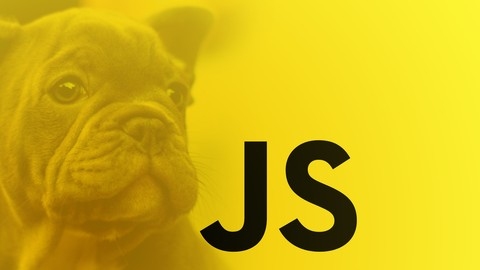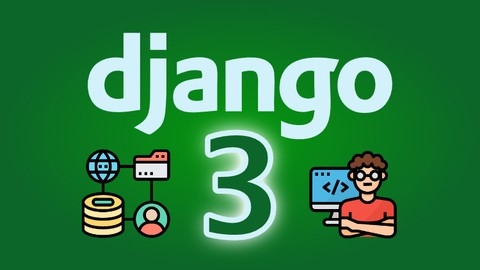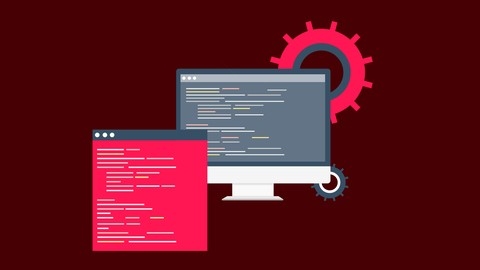Full-stack development is a highly sought-after skill in today’s tech world, allowing you to build complete web applications from front-end to back-end.
This means mastering a wide range of technologies, including HTML, CSS, JavaScript, a server-side language, and a database.
Learning full-stack development empowers you to bring your creative ideas to life and build powerful, dynamic web applications that meet real-world needs.
Finding the right full-stack course on Udemy can be overwhelming, with so many options vying for your attention.
You’re looking for a program that covers all the essential technologies, provides hands-on projects, and is taught by experienced instructors who can guide you through the process.
After carefully evaluating numerous courses, we’ve chosen “The Complete Full-Stack JavaScript Course” as the best full-stack course overall on Udemy.
This comprehensive program covers all aspects of full-stack JavaScript development, from front-end development with ReactJS and Redux to back-end development with LoopbackJS and MongoDB.
With hands-on projects, real-world applications, and clear explanations, this course provides a solid foundation for building robust, scalable, and feature-rich web applications.
While this is our top pick, there are many other great full-stack courses available on Udemy.
To find the perfect fit for your needs and interests, explore our full list of recommendations below.
We’ve curated options based on specific technologies, learning levels, and career goals.
Quick Picks
| Course Name | Skills Acquired | Enroll Now |
|---|---|---|
| Python and Django Full Stack Web Developer Bootcamp | • Front-end development (HTML, CSS, JS) • Python programming • Django framework |
👉 Go To Course |
| MERN Stack Front To Back: Full Stack React, Redux & Node.js | • MongoDB, Express, and Mongoose • React and Redux • Node.js and backend development |
👉 Go To Course |
| Beginner Full Stack Web Development: HTML, CSS, React & Node | • HTML and CSS • JavaScript and DOM Manipulation • React, Node.js, and MongoDB |
👉 Go To Course |
| Go Java Full Stack with Spring Boot and Angular | • JavaScript, TypeScript, and Angular • RESTful web services and Spring Boot • JPA and Hibernate |
👉 Go To Course |
| Full Stack: Angular and Java Spring Boot E-Commerce Website | • Angular front-end development • Spring Boot back-end development • E-commerce functionalities |
👉 Go To Course |
| Full Stack Java developer - Java + JSP + Spring Restful + JS | • Core Java and JSP/Servlets • Spring Framework • JavaScript and front-end basics |
👉 Go To Course |
| The Complete 2023 PHP Full Stack Web Developer Bootcamp | • HTML, CSS, and JavaScript • PHP and MySQL • WordPress development |
👉 Go To Course |
| Learn JavaScript: Full-Stack from Scratch | • JavaScript fundamentals • Node.js, Express, and MongoDB • Social media app development |
👉 Go To Course |
| Django 3 - Full Stack Websites with Python Web Development | • Python fundamentals • Django framework • Web development with Bootstrap |
👉 Go To Course |
| The Complete Full-Stack JavaScript Course! | • ReactJS and Redux • LoopbackJS and REST APIs • WebSocket chat application |
👉 Go To Course |
Python and Django Full Stack Web Developer Bootcamp
The course starts by covering the fundamentals of front-end web development, including HTML, CSS, Bootstrap, JavaScript, jQuery, and the Document Object Model (DOM) for creating interactive websites.
Then it dives into Python programming, teaching you the basics like numbers, strings, lists, dictionaries, tuples, sets, booleans, control flow, and functions.
It also covers more advanced Python concepts like Object Oriented Programming (OOP), errors and exceptions, regular expressions, modules, and decorators.
Once you have a solid grasp of Python, the course introduces the Django web framework.
You’ll learn how to create Django projects and applications, work with models, templates, views, URL mappings, and static files.
It covers forms for accepting user input, model forms, and form validation.
The course goes beyond the basics by teaching you how to customize Django templates using template inheritance and custom filters.
You’ll also learn about user authentication, passwords, and deploying your Django projects to production using services like PythonAnywhere and GitHub.
Additionally, the course covers advanced topics like Class-Based Views (CBVs) for more efficient coding and customizing the Django admin interface.
There are two major projects where you’ll build a blog site and a social media clone from scratch, applying everything you’ve learned.
MERN Stack Front To Back: Full Stack React, Redux & Node.js
You’ll start by setting up a MongoDB database with Atlas and connecting it to a Node.js server using Express and Mongoose.
The course dives deep into building secure user authentication with JSON Web Tokens (JWT) and implementing API routes for user registration, login, and profile management.
You’ll learn how to validate requests, create models, and implement middleware for authentication.
Once the backend is set up, you’ll move on to the frontend, where you’ll build a React application with Redux for state management.
The course covers setting up React Router for navigation and creating components for user registration and login forms.
With Redux in place, you’ll integrate alerts and build out the user authentication flow, including loading the user, setting the auth token, and implementing logout functionality.
The course then guides you through creating a dashboard and profile management system, where users can create, edit, and delete their profiles, adding details like education and experience.
You’ll also learn how to display profiles, fetch data from the GitHub API, and address console warnings.
The course dedicates a section to building out post and comment functionality, covering actions like creating, liking, unliking, deleting posts and comments.
Towards the end, you’ll prepare your application for deployment and learn how to deploy it to Heroku using the Heroku CLI.
The course also covers additional topics like creating a not-found page and addressing theme-related issues.
Throughout the course, you’ll gain hands-on experience with the MERN stack, learning how to build a full-stack application from scratch.
The instructor provides project files and links to supplementary resources like a theme-building series on YouTube.
Beginner Full Stack Web Development: HTML, CSS, React & Node
You’ll start by learning the fundamentals of HTML and CSS, including how to structure web pages, style them with colors, backgrounds, and more.
The course covers essential concepts like selectors, specificity, and responsive design principles like flexbox and CSS grids.
As you progress, you’ll dive into JavaScript, the language that brings interactivity to websites.
You’ll learn variables, arrays, loops, functions, and how to manipulate the DOM.
This prepares you for learning React, a popular JavaScript library for building user interfaces.
With React, you’ll create reusable components and manage state, crucial skills for modern web apps.
But this course doesn’t stop at the front-end.
You’ll also learn back-end development with Node.js and MongoDB.
You’ll build RESTful APIs, handle HTTP requests, work with JSON data, and integrate a MongoDB database.
This full-stack knowledge is invaluable for creating complete, data-driven web applications.
Along the way, you’ll pick up other vital skills like version control with Git, using developer tools like Chrome DevTools, and deploying your apps to a live server.
The course even covers Bootstrap 4 for rapid UI development and Sass for more maintainable CSS.
With a project-based approach and hands-on exercises, you’ll gain practical experience building websites and web apps from scratch.
Go Java Full Stack with Spring Boot and Angular
You’ll start by gaining a solid understanding of JavaScript, TypeScript, and Angular, the popular front-end framework.
The course walks you through creating an Angular application from scratch, exploring its components, data binding, routing, and more.
Moving on, you’ll dive into the world of RESTful web services and learn how to design and implement them using Spring Boot.
You’ll build REST APIs, connect them to the Angular front-end, and integrate features like basic authentication and JSON Web Tokens (JWT) for secure communication.
It covers integrating Spring Boot with JPA (Java Persistence API) and Hibernate for seamless database operations.
You’ll learn to map Java objects to database tables, perform CRUD (Create, Read, Update, Delete) operations, and leverage the power of Spring Data JPA.
The course also delves into securing your Spring Boot applications with Spring Security.
You’ll explore various security principles, authentication mechanisms (form-based, basic, JWT), authorization, and even integrate with external authentication providers like Google using OAuth2.
Throughout the journey, you’ll gain hands-on experience by building a full-fledged Todo application, complete with features like user authentication, CRUD operations for todos, and a polished user interface using Angular and Bootstrap.
The course is designed to be practical and engaging, with each step building upon the previous one.
You’ll not only learn the theoretical concepts but also apply them immediately through coding exercises and projects.
The instructor provides clear explanations, best practices, and troubleshooting tips to ensure you have a smooth learning experience.
Full Stack: Angular and Java Spring Boot E-Commerce Website
This course covers building a full-stack e-commerce application from scratch using Angular for the front-end and Spring Boot for the back-end.
It starts with crash courses on TypeScript and Angular fundamentals, ensuring you have a solid foundation.
You’ll learn how to set up development tools, create components, integrate Bootstrap CSS, and handle conditionals and formatting in Angular.
Moving on, you’ll dive into developing the Spring Boot back-end, covering JPA entities, REST APIs, and database integration.
The course guides you through building the Angular front-end, including features like product listing, searching, pagination, and shopping cart functionality.
As you progress, you’ll integrate an online shop template, add support for categories and keyword searches, and implement a master-detail view for products.
The course also covers crucial aspects like checkout form validation, saving orders to the database, and securing the application with authentication and authorization using Okta.
Additionally, you’ll learn how to handle browser refreshes, refactor the codebase, implement order history, secure communication with HTTPS, configure environments in Angular, and integrate credit card payment processing with Stripe.
The instructor provides clear explanations, coding examples, and hands-on exercises to reinforce the concepts.
You’ll have access to the source code and PDF files for reference.
Full Stack Java developer - Java + JSP + Spring Restful + JS
This comprehensive course covers all the essential technologies for becoming a full stack Java developer.
It starts by providing a strong foundation in core Java concepts like object-oriented programming, data structures like arrays and collections, multithreading, lambda expressions, and file handling.
You’ll learn how to write clean, maintainable Java code following best practices.
The course then dives into building web applications using JSP (JavaServer Pages) and Servlets.
You’ll understand the request-response lifecycle, learn to create dynamic web pages by embedding Java code, handle forms and user input, manage user sessions, and integrate web templates.
The Java Standard Tag Library (JSTL) is covered in-depth for simplifying JSP development.
Next, you’ll explore Spring, the popular Java framework for building enterprise applications.
Starting with core Spring concepts like inversion of control and dependency injection, you’ll master Spring MVC for developing web apps, Spring Security for authentication/authorization, Spring Data JPA for database integration, and Spring REST for building RESTful APIs.
The course also includes front-end JavaScript development.
You’ll learn JS from the ground up - data types, control structures, functions, working with the DOM, asynchronous programming with callbacks/promises/async-await, making HTTP requests, and more.
Popular JS array methods like map, filter, reduce are covered.
Other key topics are JUnit testing, Git version control, Hibernate ORM for database access, JSP integration with Hibernate, building a full-stack web app from scratch, and debugging techniques.
The syllabus is very detailed and comprehensive, covering all the critical technologies required for full stack Java development in-depth through hands-on coding examples.
With this course, you’ll gain the skills to design, develop, test and deploy robust, scalable, and secure full stack Java web applications.
The Complete 2023 PHP Full Stack Web Developer Bootcamp
The syllabus covers a wide range of topics, starting from the basics of web development and gradually building up to advanced concepts.
You’ll begin by understanding the fundamentals of how websites work, including protocols like HTTP, DNS, and client-server technology.
This lays a solid foundation for your journey as a full stack developer.
The course then dives into HTML5 and CSS3, teaching you how to structure and style web pages.
You’ll learn about tags, selectors, and various other elements through hands-on exercises and projects like creating a news page or a product landing page.
Once you’ve grasped the front-end technologies, the course introduces you to JavaScript, covering language syntax, functions, objects, and DOM manipulation.
You’ll even build a calculator toy and a guessing number game to reinforce your skills.
Moving on, you’ll explore the back-end with PHP, starting from the basics and progressing to advanced concepts like object-oriented programming (OOP), XML, JSON, and RESTful APIs.
The syllabus includes sections on MySQL, where you’ll learn to create databases, tables, and perform CRUD operations using PDO and MySQLi.
Interestingly, the course also covers WordPress, guiding you through setting up a complete blogging website, including domain registration, hosting, theme installation, and plugin configuration.
Throughout the course, you’ll work on various projects that integrate multiple technologies, such as a database class with OOP, CRUD operations with a Post class, and more.
This practical experience is invaluable for aspiring full stack developers.
The syllabus also includes interview questions for HTML, CSS, JavaScript, PHP, MySQL, and WordPress, helping you prepare for job interviews.
Additionally, you’ll have access to valuable resources like PHP frameworks and PHP projects.
Learn JavaScript: Full-Stack from Scratch
The course starts by covering JavaScript fundamentals like functions, objects, arrays, and control flow over 10 days.
You’ll build a to-do app, grasping concepts like higher-order functions and scope along the way.
Next, you’ll dive into server-side development with Node.js and Express, learning to create basic servers and APIs.
The course then introduces databases, teaching you to perform CRUD operations and connect your Node app to MongoDB.
With the basics covered, you’ll build a complex social media app from scratch.
You’ll implement user authentication, letting users register, log in, and upload profile photos.
The app will let users create posts, which you can view, edit, and delete.
You’ll add a live search feature, allowing users to follow each other and see a feed of posts from those they follow.
The course covers live chat using Socket.IO, form validation, preventing CSRF attacks, and creating a JSON Web Token-based API.
You’ll learn best practices like using environment variables and hashing passwords.
Finally, you’ll deploy the full app to the web and integrate email sending.
Throughout, the course emphasizes hands-on learning, guiding you step-by-step to build real-world applications.
You’ll gain experience with modern tools and libraries while picking up valuable skills for your developer journey.
Django 3 - Full Stack Websites with Python Web Development
The course starts with a Python refresher, ensuring you have the necessary foundation.
You’ll learn variables, strings, conditionals, functions, lists, loops, dictionaries, and classes – all essential Python concepts for working with Django.
The first project is a password generator app, where you’ll grasp routing, forms, views, and templates – core Django components.
You’ll install Django, understand its project structure and apps, work with URLs and templates, and integrate forms.
Plus, you’ll learn to use Bootstrap for styling.
Next, you’ll get a quick Git intro for source control, crucial for collaborative projects.
The second project, a personal portfolio site, steps up the difficulty.
You’ll work with databases, the admin dashboard, URL paths with variables, models, and queries.
You’ll create models for projects and blogs, display objects, handle static files, and extend base templates.
Bootstrap styling is covered too.
Then, you’ll deploy your portfolio site live using PythonAnywhere, learning about virtual environments, static/media files, .gitignore, and custom domains.
The third project is a CRUD todo app, where you’ll implement user authentication – signup, login, logout.
You’ll create a todo model, allowing users to create, view, update, and delete todos.
You’ll also style the app.
Finally, the course covers what’s new in Django 3, including async capabilities.
The Complete Full-Stack JavaScript Course
You’ll start by setting up your development environment and getting acquainted with the fundamentals of ReactJS, a popular JavaScript library for building user interfaces.
From there, you’ll dive into building a full-fledged ReactJS website, learning about component composition, routing, and form handling.
Along the way, you’ll create reusable components and leverage libraries like Formik for streamlined form management.
But the course doesn’t stop at the front-end.
You’ll also learn how to build a robust REST API using LoopbackJS, a powerful framework for creating APIs.
You’ll create models, define relationships, implement access control, and persist data using MongoDB.
Additionally, you’ll explore techniques for handling file uploads, custom remote methods, and user authentication.
As you progress, you’ll integrate your ReactJS front-end with the REST API using Redux, a predictable state container for JavaScript apps.
You’ll learn how to dispatch actions, create a store and reducers, and apply middleware for seamless API integration.
The course also covers Material-UI, a popular React UI framework, teaching you how to create responsive and visually appealing user interfaces.
Moving beyond traditional web applications, you’ll delve into the world of real-time communication by building a WebSocket chat application.
You’ll learn how to establish WebSocket connections, send and receive messages, implement user authentication, and track logged-in users.
Throughout the course, you’ll work on practical projects, such as a calculator, a portfolio website, a blog platform with commenting functionality, and a messenger application.
These hands-on projects will reinforce your understanding of the concepts and provide you with valuable experience in building real-world applications.
The course also covers essential topics like ESLINT for code linting, deploying React apps with NGINX, and using PM2 for managing and deploying your API.
By the end of this course, you’ll have a solid grasp of full-stack JavaScript development, enabling you to build robust, scalable, and feature-rich web applications.
